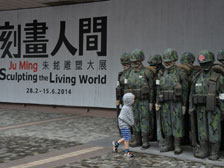
Marching orders:
The Hong Kong Museum of Art is now showcasing 120 artworks in the Ju Ming exhibition, ‘Sculpting the Living World’. Some of the outdoor exhibits attract children’s curiosity.
Marching orders:
The Hong Kong Museum of Art is now showcasing 120 artworks in the Ju Ming exhibition, ‘Sculpting the Living World’. Some of the outdoor exhibits attract children’s curiosity.
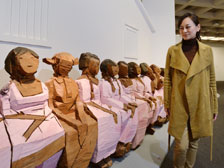
Conversation piece:
This wooden sculpture of 12 ladies was not given a title. Museum of Art Curator Mok Kar-wing said the artist wants visitors to imagine what it is all about.
Conversation piece:
This wooden sculpture of 12 ladies was not given a title. Museum of Art Curator Mok Kar-wing said the artist wants visitors to imagine what it is all about.
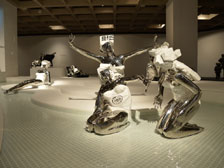
Life reflections:
Ju Ming used stainless steel to encapsulate the feeling of the human skin when sunshine falls on the shimmering body ascending from the water.
Life reflections:
Ju Ming used stainless steel to encapsulate the feeling of the human skin when sunshine falls on the shimmering body ascending from the water.
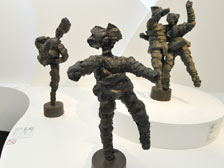
On balance:
Ju Ming used hemp cords to fasten large pieces of sponge together to create Ballerina. Leaving the cords on during the copper casting process resulted in contrasting textures.
On balance:
Ju Ming used hemp cords to fasten large pieces of sponge together to create Ballerina. Leaving the cords on during the copper casting process resulted in contrasting textures.

In lock-up:
The three-piece set Imprisonment represents the concepts of ‘prisoner’, ‘imprisoning’ and ‘self-imprisoning’.
In lock-up:
The three-piece set Imprisonment represents the concepts of ‘prisoner’, ‘imprisoning’ and ‘self-imprisoning’.
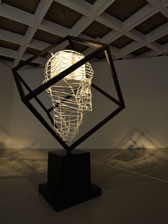
Bright idea:
A black cube encapsulates a white head, which envelops a white cube, representing mankind’s self-imposed limitations.
Bright idea:
A black cube encapsulates a white head, which envelops a white cube, representing mankind’s self-imposed limitations.
Ju Ming works reflect everyday life
April 27, 2014
World-renowned Taiwanese sculptor Ju Ming displays his exploration and understanding of life through his creation, the Living World Series. The Hong Kong Museum of Art is now showcasing 120 sculptures Ju Ming created in the last three decades.
In the first facet of the series, the Affectionate World, Ju Ming expressed his concerns about human relationships and his love towards his family. This is apparent in the work A Girl Playing with Sand which portrays his newlywed wife on the beach of Tunghsiao.
Ju Ming also looks at the living world from a wider perspective. In the Floating World, he randomly captured human figures from all walks of life. He has no ready connection to the sculptures, and the lack of details and facial expressions suggest they are strangers, and leave room for interpretation.
“He is taking snapshots of the living world and transforming them into sculptures. He intentionally did not want to give individual artworks a title, because he wants the visitors to imagine what they are about,” said museum curator Mok Kar-wing.
Consider a set of wood sculptures of 12 ladies: 11 of them are wearing pink dresses while one is left unpainted.
“They seem to be chatting quite happily, but exactly what they are talking about is up to you to imagine. And why there is one particular lady that is not painted, there is certain room for imagination allowed to the visitors, space for interaction between the artwork and the visitors,” Miss Mok said.
Innovative materials
Ju Ming’s Living World Series was first presented in wood but it has gradually expanded into other art forms. The artist constantly uses new materials, to elaborate on the beauty of body movements.
“He always says material has its own temperament. Each type of material is different. It all depends on whether you can handle it properly.”
In the group of work Swimming, Ju Ming used stainless steel to portray a shimmering body ascending from the water.
“The use of the material has fully encapsulated that feeling of the human skin next to the swimming pool,” Miss Mok noted.
In the piece Ballerina, Ju Ming used hemp cords to wrap and fasten large pieces of sponge. He retained the cords during the copper casting process so the resulting sculpture combines the two contrasting textures of the sponge and copper.
Identifying boundaries
The third facet, Carefree World, represented by Imprisonment and Cube, marks a turning point in Ju Ming’s creation, expressing not only the aesthetics of forms, but exploring deeper philosophical questions of life.
The artwork Cube is a sculpture of a white head inside a black cube. Within the head, though, is another white cube.
“Frameworks and squares are abstract representation of limitation. The artist is questioning whether civilisation has been over-developed, and whether we, mankind, has incurred limitations on ourselves. And if so, how do we break through?”
The three-piece set of sculptures Imprisonment, explores the concept of imprisoning and self-imprisoning.
The first cage contains a newlywed couple, but the key is left in the lock inside the cage.
“So who is really putting them into the cage? Are they really free to go or are they willing to stay within this prison?” asks Miss Mok.
The middle cage is half white and half black, with a person standing in each half. There is no boundary between them, though, and they can easily swap places. So Miss Mok asks, who is being imprisoned, and is it self-imposed?
In the third cage, prisoners were locked up with no means of escape. The three cages reverberate with questions on the issues of what limits us, and who is setting these limits.
“[Ju Ming] always says that we could be kind, we could be evil. We could be smart and at the same time foolish. Whether we decide to be kind or evil, smart or foolish, is all a decision made by us, in a split second.”
The exhibition is at the Hong Kong Museum of Art until June 15. Click here for details.